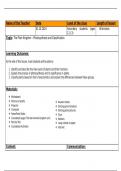Name of the Teacher Date Level of the class Length of lesson
01.10.2024 Secondary students (ages 60 minutes
12-13)
Topic: The Plant Kingdom – Photosynthesis and Classification
Learning Outcomes:
At the end of this lesson, most students will be able to:
1. Identify and describe the main parts of plants and their functions.
2. Explain the process of photosynthesis and its significance in plants.
3. Classify plants based on their characteristics and explain the differences between these groups.
Materials:
Whiteboard
Pictures of plants Answer sheets
Projector Sorting game handouts
Computer Sorting game pictures
PowerPoint Slides Glue
Coursebook page (The Non-Animal kingdom unit) Markers
Pencils/ Pen Large sheets of paper
Coursebook Activities Internet
Content: Communication:
, Students will learn, use, and understand…
Students will be able to…
Language of: (Words for input) Roots, stems, leaves,
1. Demonstrate their understanding of plant structure by labelling the chloroplasts, glucose, carbon dioxide, water,
basic parts of a plant on a diagram. photosynthesis, bryophytes, vascular plants, non-vascular,
tracheophytes, pteridophytes, gymnosperms, angiosperms.
2. Explain the steps involved in the process of photosynthesis,
describing how plants make food. Language for: (Additional language needed)
Identifying, describing processes, explaining functions,
3. Categorize plants based on their characteristics and explain the categorizing, classifying plants, and comparing.
differences between these groups.
Language through: (Sentence stems for task (if
applicable) and output) Describing: I can see..., This
is..., It is..., Photosynthesis involves..., The function of the
[plant part] is..., Plants make food by..., Explaining:
Photosynthesis is important because…., This process helps
plants by…, Chloroplasts are responsible for...,
Identifying: This part of the plant is called..., The process
of photosynthesis occurs in...., Categorizing: This plant is
classified as... because..., These plants belongs to..., Non-
vascular plants include..., They falls under...
Cognition: (*remember to include the Bloom stages students will be using) Culture:
1. To identify and describe the basic parts of a plant, including roots, 1. To understand how plant processes, such as
stems, leaves, and reproductive structures. (Bloom's Taxonomy: photosynthesis, influence environmental conditions and
Remembering) contribute to ecosystem health, including impacts on air
quality and soil fertility.
2. To explain the process of photosynthesis and understand the role
played by each part of the plant. (Bloom's Taxonomy: 2. To appreciate the wide variety of plant species and their
Understanding) roles in maintaining ecological balance and supporting
biodiversity.
, 3. To analyse pictures of different types of plants and classify them
based on their characteristics. (Bloom's Taxonomy: Analyzing and 3. To recognize the everyday significance of plants,
evaluating) including their contributions to food production, clothing
materials, and other daily necessities.
Assessment Criteria: Students will accurately label the main parts of a plant on a diagram, clearly explain the process of
photosynthesis, and analyze pictures of different types of plants, evaluating their characteristics and classifying them into appropriate
categories.
Stage Stage Aim Time Interact Teacher’s procedure Students will… Materi
Name ion als
Pattern
Introduction To introduce the 4 mins T-S Welcome the students to class. Feel welcomed and Whiteboar
topic, engage Introduce the topic of the lesson, engaged from the start. d
students' interest learning objectives and write them Understand the
and set the stage on the board. objectives and focus of
Read the objectives aloud and the lesson.
for the lesson.
briefly explain each one to ensure
students understand what they will
be learning.
Inform students that today’s lesson
will focus on understanding
different aspects of plants,
including their structure, how they
produce food, and their
classification.
Activating To activate 6 mins T-S Project pictures of various plants Observe and identify Whiteboar
knowledge students' prior onto the whiteboard. (Fig 1) plants from the d
knowledge about Ss-Ss Ask students to identify and name pictures.
plants and set the any plants or plant parts they Participate in the Projector
recognize. Use prompts such as, discussion by sharing
context for the new
"Which of these plants do you their knowledge of
lesson by know?" or "Can you name any of familiar plants, plant Computer
connecting their the plant parts shown?" parts and their




